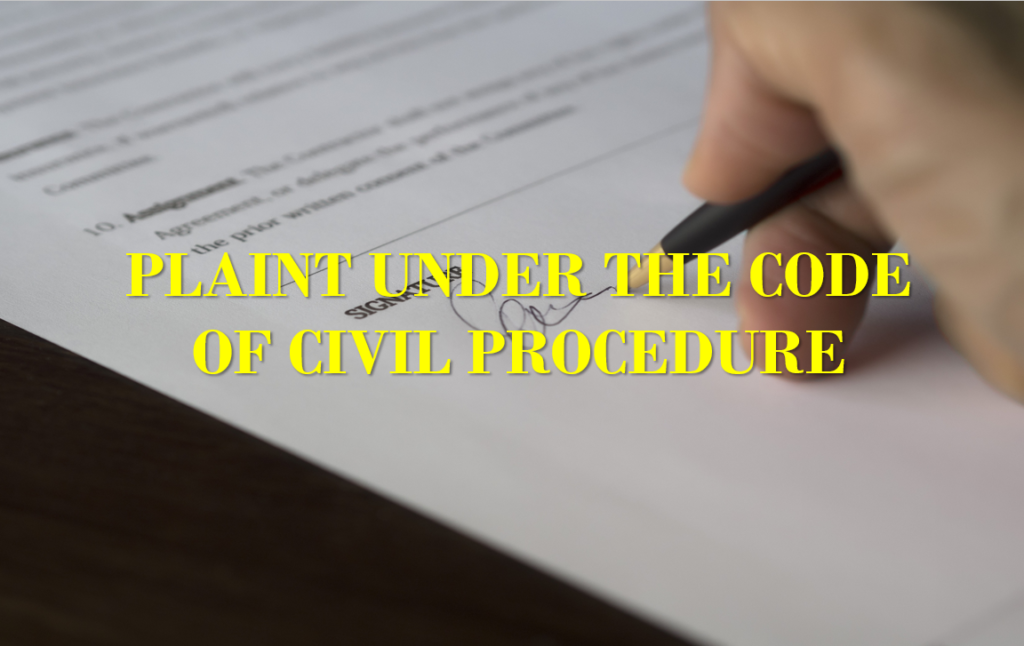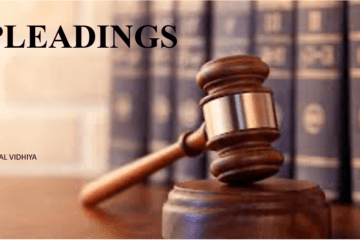
Meaning of Plaint
A plaint can be understood as a statement of claim, a document, by presentation of which the suit is instituted. Its object is to state the grounds upon which the assistance of the court is sought by the plaintiff. It is a pleading of the plaintiff.
Order VII of the Code deals with plaint.
Particulars of a paint: Rule 1 to 8
Every plaint should contain the following particulars:
Name of the court in which suit is brought [Rule 1(a)]
The name, description and place of residence of plaintiff [Rule 1(b)]
The name, description and place of residence of defendant [Rule 1(c)]
Where the plaintiff or defendant is a minor or person of unsound mind, the statement to that effect [Rule 1(d)]
The facts constituting the cause of action and where it arose [Rule 1(e)]
The facts showing that the Court has jurisdiction [Rule 1(f)]
A statement of the value of the subject-matter of the suit for the purpose of jurisdiction and court fees [Rule 1(i)]
The reliefs claimed by the plaintiff, simply or in the alternative [Rule 1(g), 7 & 8]
Where the plaintiff files a suit in a representative capacity, the facts showing that the plaintiff has an actual existing interest in the subject-matter and that he has taken steps that may be necessary to enable him to file a suit [Rule 4]
Where the plaintiff has allowed a set-off or relinquished a portion of his claim, the amount so allowed or relinquished [Rule 1(h)]
Where the suit is for recovery of money, the precise amount claimed [Rule 2]
Where the suit is for accounts or mesne profit or for movables in the possession of the defendant of God debts which cannot be determined, the sprucing amount of value thereof [Rule 2]
Where the subject-matter of the suit is immovable property, a description of the property sufficient to identify it, e.g., boundaries, survey numbers, etc. [Rule 3]
The interest and liability of the defendant in the subject-matter of the suit [Rule 5]
Where the suit is time-barred, the ground upon which the exception from the law of limitation is claimed [Rule 6]
Admission of Plaint: Rule 9
Rule 9 lays down the procedure when the plaint is admitted by the Court. It provides for filing of copies of the paint by the plaintiff and also requires him to pay requisite fees for the service of summons on the defendant within seven days.
Return of Paint: Rule 10, 10-A, 10-B
Where at any stage of the suit, the city finds that it has no jurisdiction, either territorial or pecuniary or with regard to subject-matter of the suit, it will return the plaint to be presented to the proper court in which the suit ought to have been filed. However, the Court cannot dismiss the suit.
Rule 10-A prescribes the procedure to be followed by a Court before the plaint is ordered to be returned to be presented to the proper court. It is inserted to obviate the necessity of serving the summons on the defendant where the return of plaint is made after the appearance of the defendants in the suit.
Rule 10 – B states that in the event of filing an appeal against the order of return, if the Appellate Court confirms such order, it may direct the plaintiff to file the plaint in the proper court, subject to limitation and may also fix a date of appearance before such court (the court to which it is sent need not issue fresh
summons unless required)
Rule 10 (2) states that the Judge returning the plaint should make endorsements on it regarding the date of presentation, the date of return, the name of the party presenting it and reasons for returning it.
Grounds of Rejection of Plaint
The grounds for rejection of plaint includes the following:
- Where it does not disclose the cause of action- if the plaintiff fails to mention the facts which give him right to seek relief against the defendant and the necessary facts that are required to prove wrong done by a defendant against the plaintiff, then in such cases the plaint can be rejected.
- Where the relief claimed by the plaintiff is undervalued, or fails to correct the same on the direction of the court within a given period.
- Where plaint is properly valued and relief under it but the plaint gets rejected on the ground of insufficient papers or papers not properly attested or stamped, where the plaintiff does not present the plaint in accordance to the Court-fees Act.
- Where the suit is time-barred.
- In every suite, a duplicate file of the plaint needs to be filed by the plaintiff. If this requirement is not fulfilled, the plaint is rejected.
- Where the plaintiff fails to act in accordance with Rule 7 and Rule 9, the plaint can be rejected.




0 Comments